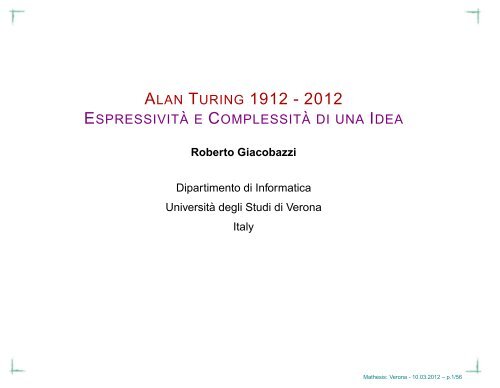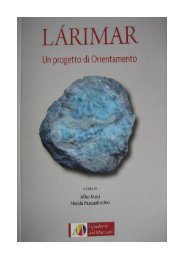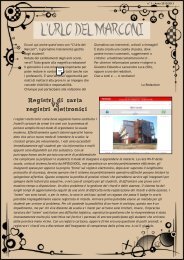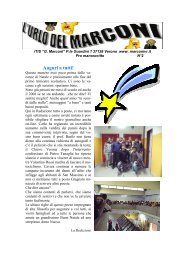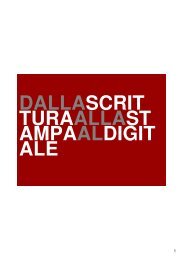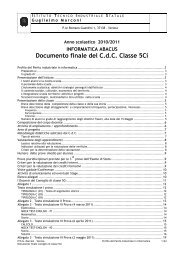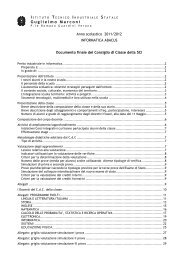Link alle Slide Conferenza La Macchina di Turing - ITIS G. Marconi
Link alle Slide Conferenza La Macchina di Turing - ITIS G. Marconi
Link alle Slide Conferenza La Macchina di Turing - ITIS G. Marconi
Create successful ePaper yourself
Turn your PDF publications into a flip-book with our unique Google optimized e-Paper software.
ALAN TURING 1912 - 2012<br />
ESPRESSIVITÀ E COMPLESSITÀ DI UNA IDEA<br />
Roberto Giacobazzi<br />
Dipartimento <strong>di</strong> Informatica<br />
Università degli Stu<strong>di</strong> <strong>di</strong> Verona<br />
Italy<br />
Mathesis: Verona - 10.03.2012 – p.1/56
Un po’ <strong>di</strong> storia<br />
Espressività e complessità<br />
Automi<br />
Automi a pila<br />
Macchine <strong>di</strong> <strong>Turing</strong> limitate<br />
Macchine <strong>di</strong> <strong>Turing</strong> ed il limite del calcolabile<br />
Protezione del co<strong>di</strong>ce<br />
DNA computers<br />
Quantum computers<br />
Cosa vedremo<br />
Mathesis: Verona - 10.03.2012 – p.2/56
Breve storia: Le origini<br />
1900 Hilbert: 23rd: Find a method for deci<strong>di</strong>ng the truth or falsity of any<br />
statement of pre<strong>di</strong>cate calculus (decision procedure)<br />
Programma hilbertiano (1904): riduzione della matematica ad un mero<br />
calcolo <strong>di</strong> simboli privi <strong>di</strong> significato in un sistema <strong>di</strong> assiomi e regole<br />
(metamatematica)<br />
Riduzionismo laplaciano<br />
Certezza algebrica come manipolazione meccanica <strong>di</strong> simboli<br />
(algebristi inglesi: Woodhouse 1801, Boole 1854, Babbage 1834)<br />
Sviluppo industriale: macchine!<br />
Mathesis: Verona - 10.03.2012 – p.3/56
Breve storia: Le origini<br />
1900 Hilbert: 23rd: Find a method for deci<strong>di</strong>ng the truth or falsity of any<br />
statement of pre<strong>di</strong>cate calculus (decision procedure)<br />
Programma hilbertiano (1904): riduzione della matematica ad un mero<br />
calcolo <strong>di</strong> simboli privi <strong>di</strong> significato in un sistema <strong>di</strong> assiomi e regole<br />
(metamatematica)<br />
1930/1 Gödel: Incompletezza e crisi del programma hilbertiano<br />
Indeci<strong>di</strong>bilità: Proposizioni indeci<strong>di</strong>bili nell’artimetica<br />
Critica <strong>di</strong> Poincarè e Weyl (1927) a Hilbert (1905): consistenza della<br />
metamatematica<br />
Intuizionismo Brower (1927)<br />
Mathesis: Verona - 10.03.2012 – p.3/56
Breve storia: Le origini<br />
1900 Hilbert: 23rd: Find a method for deci<strong>di</strong>ng the truth or falsity of any<br />
statement of pre<strong>di</strong>cate calculus (decision procedure)<br />
Programma hilbertiano (1904): riduzione della matematica ad un mero<br />
calcolo <strong>di</strong> simboli privi <strong>di</strong> significato in un sistema <strong>di</strong> assiomi e regole<br />
(metamatematica)<br />
1930/1 Gödel: Incompletezza e crisi del programma hilbertiano<br />
Indeci<strong>di</strong>bilità: Proposizioni indeci<strong>di</strong>bili nell’artimetica<br />
1936 <strong>Turing</strong>: Cosa significa "calcolare"?<br />
<strong>Macchina</strong> o modello?<br />
<strong>Macchina</strong> <strong>di</strong> <strong>Turing</strong> (1936)<br />
<strong>La</strong>mbda-calclo (1928-36) <strong>di</strong> Church e Curry<br />
Funzioni parziali ricorsive (1936) <strong>di</strong> Kleene<br />
Mathesis: Verona - 10.03.2012 – p.3/56
Breve storia: Le origini<br />
1900 Hilbert: 23rd: Find a method for deci<strong>di</strong>ng the truth or falsity of any<br />
statement of pre<strong>di</strong>cate calculus (decision procedure)<br />
Programma hilbertiano (1904): riduzione della matematica ad un mero<br />
calcolo <strong>di</strong> simboli privi <strong>di</strong> significato in un sistema <strong>di</strong> assiomi e regole<br />
(metamatematica)<br />
1930/1 Gödel: Incompletezza e crisi del programma hilbertiano<br />
Indeci<strong>di</strong>bilità: Proposizioni indeci<strong>di</strong>bili nell’artimetica<br />
1936 <strong>Turing</strong>: Cosa significa "calcolare"?<br />
<strong>Macchina</strong> o modello?<br />
1936 Tesi <strong>di</strong> Church-turing: Le funzioni intuitivamente calcolabili sono tutte e<br />
sole le funzioni <strong>Turing</strong>-calcolabili<br />
Informatica come scienza dell’informazione<br />
In<strong>di</strong>pendenza dalla macchina<br />
Profonda ra<strong>di</strong>ce logico-matematica<br />
Mathesis: Verona - 10.03.2012 – p.3/56
Evoluzione storica<br />
<br />
<br />
Mathesis: Verona - 10.03.2012 – p.4/56
Evoluzione storica<br />
<br />
<br />
<br />
Mathesis: Verona - 10.03.2012 – p.4/56
Evoluzione storica<br />
<br />
<br />
<br />
Mathesis: Verona - 10.03.2012 – p.4/56
Evoluzione storica<br />
<br />
<br />
<br />
Mathesis: Verona - 10.03.2012 – p.4/56
e prima?<br />
Mathesis: Verona - 10.03.2012 – p.5/56
a) Un algoritmo è <strong>di</strong> lunghezza finita.<br />
Il concetto <strong>di</strong> algoritmo<br />
b) Esiste un agente <strong>di</strong> calcolo che porta avanti il calcolo eseguendo le<br />
istruzioni dell’algoritmo.<br />
c) L’agente <strong>di</strong> calcolo ha a <strong>di</strong>sposizione una memoria dove vengono<br />
immagazzinati i risultati interme<strong>di</strong> del calcolo.<br />
d) Il calcolo avviene per passi <strong>di</strong>screti.<br />
e) Il calcolo non è probabilistico.<br />
f) Non deve esserci alcun limite finito alla lunghezza dei dati <strong>di</strong> ingresso.<br />
g) Non deve esserci alcun limite alla quantità <strong>di</strong> memoria <strong>di</strong>sponibile.<br />
h) Deve esserci un limite finito alla complessità delle istruzioni eseguibili dal<br />
<strong>di</strong>spositivo.<br />
i) Sono ammesse esecuzioni con un numero <strong>di</strong> passi illimitato.<br />
Mathesis: Verona - 10.03.2012 – p.6/56
Evitare il paradosso <strong>di</strong>agonale!<br />
<br />
<br />
<strong>La</strong> Teoria descrive tutti gli Algoritmi<br />
Per (a+h): |Algoritmi| = N<br />
Per (f): Algoritmi : N −→ N<br />
φ<br />
Con quale scopo?<br />
<br />
A0(x),A1(x),A2(x),A3(x),.... sono una enumerazione degli Algoritmi<br />
Sia h(x) = Ax(x)+1 ....h ∈ Algoritmi?<br />
Mathesis: Verona - 10.03.2012 – p.7/56
Gödel <strong>di</strong>sse:<br />
Tarski has stressed in his lecture (and I think justly)<br />
the great importance of the concept of general<br />
recursiveness (or <strong>Turing</strong>’s computability). It seems to<br />
me that this importance is largely due to the fact that<br />
with this concept one has for the first time succeeded<br />
in giving an absolute definition of an interesting<br />
epistemological notion, i.e. one not depen<strong>di</strong>ng on the<br />
formalism chosen. [ . . . ] By a kind of miracle it is not<br />
necessary to <strong>di</strong>stinguish orders and the <strong>di</strong>agonal<br />
procedure does not lead outside the defined notion.<br />
[K. Gödel, Princeton 1946]<br />
Mathesis: Verona - 10.03.2012 – p.8/56
Informazione e Informatica<br />
Mathesis: Verona - 10.03.2012 – p.9/56
<strong>Macchina</strong> o modello <strong>di</strong> calcolo<br />
Co<strong>di</strong>fica dati in un alfabeto Σ<br />
Co<strong>di</strong>fica descrizione istantanea<br />
Co<strong>di</strong>fica programma<br />
?<br />
Mathesis: Verona - 10.03.2012 – p.10/56
<strong>Macchina</strong> o modello <strong>di</strong> calcolo<br />
Co<strong>di</strong>fica dati in un alfabeto Σ<br />
Co<strong>di</strong>fica descrizione istantanea<br />
Co<strong>di</strong>fica programma<br />
Dispositivo<br />
Risorse (memoria e tempo)<br />
Descrizione <strong>di</strong> transizione <strong>di</strong> stato<br />
(tipo <strong>di</strong> calcolo)<br />
Mathesis: Verona - 10.03.2012 – p.10/56
<strong>Macchina</strong> o modello <strong>di</strong> calcolo<br />
Co<strong>di</strong>fica dati in un alfabeto Σ<br />
Co<strong>di</strong>fica descrizione istantanea<br />
Co<strong>di</strong>fica programma<br />
Collezione <strong>di</strong> insiemi e relazioni<br />
Sequenze <strong>di</strong> simboli<br />
Funzione <strong>di</strong> transizione <strong>di</strong> stato<br />
Mathesis: Verona - 10.03.2012 – p.10/56
<strong>Macchina</strong> o modello <strong>di</strong> calcolo<br />
Co<strong>di</strong>fica dati in un alfabeto Σ<br />
Co<strong>di</strong>fica descrizione istantanea<br />
Co<strong>di</strong>fica programma<br />
Informatica come scienza <strong>di</strong> modelli<br />
Mathesis: Verona - 10.03.2012 – p.10/56
Sia M una data macchina (o modello <strong>di</strong> calcolo)<br />
Sia Σ un alfabeto <strong>di</strong> simboli<br />
Una misura della espressività<br />
Sia σ ∈ Σ ∗ una sequenza finita arbitrariamente lunga <strong>di</strong> simboli (parola)<br />
M |= σ se la macchina M termina accettando σ<br />
Il linguaggio <strong>di</strong> M: L(M) def<br />
=<br />
<br />
σ ∈ Σ ∗ M |= σ<br />
L(M) è un insieme <strong>di</strong> parole (linguaggio)<br />
M1 è più potente <strong>di</strong> M2 se L(M2) ⊆ L(M1)<br />
<br />
Mathesis: Verona - 10.03.2012 – p.11/56
Espressività e Complessità<br />
Complessità: Quanto è <strong>di</strong>fficile risolvere un problema che sappiamo essere<br />
risolvibile?<br />
Espressività Si può risolvere un dato problema con un certo strumento<br />
(macchina o modello)?<br />
Difficoltà = consumo risorse (Es: tempo/spazio)<br />
Cosa è una classe?<br />
Complessità = Espressività con risorse limitate<br />
Come limitiamo le risorse?<br />
Se M è un famiglia <strong>di</strong> macchine:<br />
C(M) def<br />
<br />
= L ⊆ Σ ∗ ∃M ∈ M : L = L(M)<br />
Come si struttura la espressività al variare delle macchine?<br />
Quali proprietà <strong>di</strong> chiusura caratterizzano le classi?<br />
<br />
Mathesis: Verona - 10.03.2012 – p.12/56
<strong>La</strong> gerarchia <strong>di</strong> Chomsky<br />
<br />
<br />
<br />
<br />
<br />
Mathesis: Verona - 10.03.2012 – p.13/56
...me<strong>di</strong>ante proce<strong>di</strong>menti intuitivamente “calcolabili”!!<br />
<strong>La</strong> gerarchia <strong>di</strong> Chomsky<br />
<br />
<br />
<br />
<br />
<br />
Mathesis: Verona - 10.03.2012 – p.13/56
Completezza e classi<br />
<br />
<strong>La</strong> funzione <strong>di</strong> riduzione −→ ha complessità A<br />
Se B−completi ⊆ A ⇒ A = B<br />
Mathesis: Verona - 10.03.2012 – p.14/56
Percorrendo la gerarchia: Automi<br />
<br />
Legge dal nastro 1 simbolo alla volta<br />
Esegue transizioni <strong>di</strong> stato <strong>di</strong>screte<br />
<br />
<br />
Gli stati sono finiti: n ∈ N fissati a priori! (es. processore)<br />
Non ha memoria!<br />
Mathesis: Verona - 10.03.2012 – p.15/56
Distinguere numeri pari e numeri <strong>di</strong>spari<br />
11111111111111111111111111111111<br />
<br />
<br />
<br />
<br />
Un esempio<br />
Mathesis: Verona - 10.03.2012 – p.16/56
Non riesce a contare: a n b n per n ∈ N<br />
<br />
<br />
<br />
<br />
a1 a2 a3 ... b1 b2 b3 ... c1 c2 c3 ... accettato!<br />
a1 a2 a3 ... b1 b2 b3 ... b1 b2 b3 ... c1 c2 c3 ... accettato!<br />
a1 a2 a3 ... b1 b2 b3 ... b1 b2 b3 ... b1 b2 b3 ... c1 c2 c3 ... accettato!<br />
....<br />
<br />
Limiti<br />
Mathesis: Verona - 10.03.2012 – p.17/56
Idea<br />
Aumentiamo la potenza:<br />
Par<strong>alle</strong>lismo vs non-determinismo<br />
Permettiamo alla macchina <strong>di</strong> attivare processi in<strong>di</strong>pendenti e par<strong>alle</strong>li<br />
Transizione : Stati −→ 2 Stati<br />
Ad ogni passo i processi attivati sono finiti < ∞<br />
Senza limiti <strong>di</strong> tempo: Sequenziale = Non−deterministico<br />
C(ASFD) = C(ASFND)<br />
Non si aumenta la espressività degli automi amuentandone il grado <strong>di</strong><br />
par<strong>alle</strong>lismo!!<br />
Mathesis: Verona - 10.03.2012 – p.18/56
Il modello non-deterministico<br />
<br />
Mathesis: Verona - 10.03.2012 – p.19/56
Il modello non-deterministico<br />
<br />
<br />
<br />
<br />
Mathesis: Verona - 10.03.2012 – p.20/56
Percorrendo la gerarchia: Automi a Pila<br />
<br />
Legge dal nastro 1 simbolo alla volta<br />
<br />
Esegue transizioni <strong>di</strong> stato <strong>di</strong>screte (Automa)<br />
Gli stati sono finiti: n ∈ N fissati a priori! (Automa)<br />
Può memorizzare i simboli su una pila (LIFO)<br />
<br />
<br />
Ha una memoria ma limitata nelle azioni (LIFO)!<br />
<br />
Mathesis: Verona - 10.03.2012 – p.21/56
q0 ε a b c<br />
Z q0,ZA q0,ZB q1,ε<br />
A<br />
B<br />
Un esempio<br />
q1 ε a b c<br />
Z q1,Z q1,Z<br />
A q1,ε q1,Z q1,Z<br />
B q1,Z q1,ε q1,Z<br />
L’automa conta: riconosce le sequenze palindrome: abbcbba!!!<br />
Risolve il problema a n b n ...<br />
Mathesis: Verona - 10.03.2012 – p.22/56
a bcba<br />
↓ nastro<br />
q0<br />
↕ pila<br />
Z<br />
abc b a<br />
↓ nastro<br />
q1<br />
↕ pila<br />
B A<br />
⇒<br />
⇒<br />
a b cba<br />
↓ nastro<br />
q0<br />
↕ pila<br />
Z A<br />
abcb a<br />
↓ nastro<br />
q1<br />
↕ pila<br />
A<br />
⇒<br />
⇒<br />
ab c ba<br />
abcba<br />
↓ nastro<br />
q0<br />
↕ pila<br />
Z BA<br />
↓ nastro<br />
q1<br />
↕ pila<br />
Mathesis: Verona - 10.03.2012 – p.23/56
Non riesce a confrontare 3 numeri: a n b n c n<br />
Non-detreminismo è più espressivo del determinismo:<br />
APND: ww r , esempio: abbabbabba<br />
APD: wcw r , esempio: abbabcbabba<br />
C(APD) ⊂ C(APND)<br />
Gli APD sono i parsers dei moderni compilatori (Grammatice Libere da<br />
Contesto).<br />
Limiti<br />
Mathesis: Verona - 10.03.2012 – p.24/56
Percorrendo la gerarchia: MdT limitata in Spazio<br />
Idea: Memoria libera ma limitata in spazio da f(input)<br />
<br />
Legge e scrive sul nastro 1 simbolo alla volta<br />
Esegue transizioni <strong>di</strong> stato <strong>di</strong>screte (Automa)<br />
Gli stati sono finiti: n ∈ N fissati a priori! (Automa)<br />
<br />
<br />
Mathesis: Verona - 10.03.2012 – p.25/56
Limiti e proprietà nello spazio<br />
Nuove classi in spazio:<br />
Space[f(n)] problemi (linguaggi) risolvibili con f(n) memoria (celle)<br />
Lo spazio non <strong>di</strong>pende dal numero <strong>di</strong> nastri!<br />
Tape compression: Space[f(n)] = Space[c·f(n)] con c > 0<br />
Aumentando la co<strong>di</strong>fica dell’alfabeto e degli stati!<br />
Se f(n) ≤ g(n) allora Space[f(n)] ⊆ Space[g(n)]<br />
Cosa succede se confrontiamo determinismo SpaceD con<br />
non-determinismo SpaceN?<br />
Mathesis: Verona - 10.03.2012 – p.26/56
Classi e proprietà nello spazio<br />
EXPSpace = <br />
c>0 SpaceD[2 c·n ]<br />
PSpace = <br />
c>0 SpaceD[n c ]<br />
NPSpace = <br />
c>0 SpaceN[n c ]<br />
LSpace = SpaceD[logn]<br />
NLSpace = SpaceN[logn]<br />
LSpace ⊆ NLSpace ⊆ PSpace ⊆ NPSpace ⊆ EXPSpace<br />
Nello spazio determinismo equivale a non-determinismo (...quasi sempre)<br />
PSpace = NPSpace<br />
LSpace ? = NLSpace<br />
Mathesis: Verona - 10.03.2012 – p.27/56
Percorrendo la gerarchia: MdT limitata in Tempo<br />
Idea: Memoria libera ma limitata in tempo da f(input)<br />
<br />
Legge e scrive sul nastro 1 simbolo alla volta<br />
Esegue transizioni <strong>di</strong> stato <strong>di</strong>screte (Automa)<br />
<br />
<br />
Gli stati sono finiti: n ∈ N fissati a priori! (Automa)<br />
Esegue per al più f(input) passi<br />
1994 Deneba Systems, Inc.<br />
Mathesis: Verona - 10.03.2012 – p.28/56
Limiti e proprietà nel tempo<br />
Nuove classi in tempo:<br />
Time[f(n)] problemi (linguaggi) risolvibili in f(n) passi<br />
Es: moltiplicazione è in Time[n 2 ], sorting in Time[n logn]<br />
Speed-up: Time[f(n)] = Time[c·f(n)] con c > 0.<br />
Il tempo <strong>di</strong>pende in minima misura dal numero <strong>di</strong> nastri<br />
Multitape M, monotape N: TimeN ≤ c·(TimeM) 2<br />
Cosa succede se confrontiamo determinismo TimeD con<br />
non-determinismo TimeN?<br />
Mathesis: Verona - 10.03.2012 – p.29/56
Classi e proprietà nel tempo<br />
PTime = <br />
c>0 TimeD[n c ]<br />
NPTime = <br />
c>0 TimeN[n c ]<br />
EXPTime = <br />
c>0 TimeD[2 n·c ]<br />
NEXP = <br />
c>0 TimeN[2 n·c ]<br />
Nel tempo determinismo e non-determinismo correlati?<br />
PTime ⊆ NPTime ⊆ PSpace<br />
PTime ? = NPTime<br />
PTime ⊂ EXPTime<br />
Church-<strong>Turing</strong> Thesis: a function computable in<br />
polynomial time in any reasonable computational<br />
model using a reasonable time complexity measure is<br />
computable by a deterministic <strong>Turing</strong> Machine in<br />
polynomial time.<br />
Mathesis: Verona - 10.03.2012 – p.30/56
Percorrendo la gerarchia: MdT<br />
Idea: Nessun limite <strong>di</strong> tempo/spazio alla gestione della memoria<br />
Legge e scrive sul nastro 1 simbolo alla volta<br />
Esegue transizioni <strong>di</strong> stato <strong>di</strong>screte (Automa)<br />
Gli stati sono finiti: n ∈ N fissati a priori! (Automa)<br />
Ha tempo e spazio ∞<br />
Ammettimo non-determinismo<br />
Chiaramente (tesi <strong>di</strong> Church):<br />
C(MdTD) = C(MdTND)<br />
Mathesis: Verona - 10.03.2012 – p.31/56
MdT: Il modello<br />
Mathesis: Verona - 10.03.2012 – p.32/56
Limiti e Proprietà assolute<br />
Il problema della terminazione<br />
Ogni programma P ha una sua co<strong>di</strong>fica nei dati: 〈P〉 ∈ Dati<br />
<strong>La</strong> macchina è universale (interprete):<br />
<br />
P(x) se P(x) termina<br />
Int(P,x) =<br />
↑ altrimenti<br />
<strong>La</strong> macchina può <strong>di</strong>vergere!!<br />
<br />
<br />
(P,x) P(x) converge<br />
<br />
non è deci<strong>di</strong>bile<br />
Se lo fosse, allora sia D(P,x) il programma che decide se P(x)↓<br />
<br />
↑ se D(P,〈P〉) = Y<br />
Costruiamo H(P) =<br />
1 se D(P,〈P〉) = N<br />
H(〈H〉)↓ sse D(H,〈H〉) = N sse H(〈H〉)↑<br />
Assurdo!<br />
Mathesis: Verona - 10.03.2012 – p.33/56
E senza limiti?<br />
Nessun limite <strong>di</strong> tempo e spazio ....il problema è quello <strong>di</strong> <strong>Turing</strong> del<br />
1936!!<br />
Possiamo solo <strong>di</strong>re se un problema è calcolabile!<br />
<strong>Turing</strong> argument:<br />
ammette una soluzione algoritmica<br />
tutto ruota intorno alla <strong>Macchina</strong> <strong>di</strong> <strong>Turing</strong> Universale!<br />
Assumiamo termination(P) termina e <strong>di</strong>ce true iff P<br />
termina su tutti gli inputs<br />
E che ne è <strong>di</strong>:<br />
P ≡ while termination(P){ null } ?<br />
Mathesis: Verona - 10.03.2012 – p.34/56
<strong>La</strong> gerarchia rivista<br />
<br />
<br />
<br />
<br />
<br />
Mathesis: Verona - 10.03.2012 – p.35/56
Le Storie <strong>di</strong> Erodoto...<br />
Nascondere informazioni<br />
Watermarks introdotti per la prima volta a Bologna, nel 1282!<br />
Il termine "<strong>di</strong>gital watermark" fu introdotto nel 1992 da Tirkel e Osborne,<br />
nel paper: A.Z.Tirkel, G.A. Rankin, R.M. Van Schyndel, W.J. Ho, N.R.A.<br />
Mee, C.F. Osborne. “Electronic Water Mark”. DICTA 93, Macquarie<br />
University. p. 666-673<br />
Nel SW: F. Cohen. Operating system protection through program<br />
evolution. Computer & Security 12(6):56-584, 1993.<br />
Mathesis: Verona - 10.03.2012 – p.36/56
Offuscamento: l’idea<br />
Mathesis: Verona - 10.03.2012 – p.37/56
Offuscamento: l’idea<br />
Mathesis: Verona - 10.03.2012 – p.38/56
Oggetti da nascondere?<br />
data objects<br />
source code<br />
control mechanisms<br />
module organization<br />
function names<br />
values (crypto keys, license etc).<br />
Dove sono gestite queste entità?<br />
Il significato <strong>di</strong> “essere a fuoco”<br />
.... nella Semantica!!!<br />
<strong>La</strong> semantica concreta <strong>di</strong> un programma formalizza (è un modello<br />
matematico) le possibili esecuzioni del programma in ogni possibile<br />
ambiente <strong>di</strong> utilizzo!<br />
Mathesis: Verona - 10.03.2012 – p.39/56
<strong>La</strong> semantica<br />
Mathesis: Verona - 10.03.2012 – p.40/56
Oscurità come imprecisione<br />
Offuscare un programma significa rendere un interprete impreciso<br />
ρ è una approssimazione <strong>di</strong> Σ (dati, stati, tracce <strong>di</strong> stati etc)<br />
Una trasformazione τ : P → P tale che [[P]] = [[τ(P)]] (stessa funzione)<br />
ρ([[τ(P)]]) ❁ [[τ(P)]] ρ imprecisione!<br />
Mathesis: Verona - 10.03.2012 – p.41/56
Oscurità come imprecisione<br />
Offuscare un programma significa rendere un interprete impreciso<br />
P : x = a∗b<br />
Sign è approssimazione <strong>di</strong> ℘(Z):<br />
... ...<br />
0−<br />
℘(Z)<br />
0+<br />
...<br />
{−1,−3,−4} {2,3,5}<br />
... 0 1 ...<br />
∅<br />
0−<br />
℘(Z)<br />
∅<br />
0<br />
0+<br />
Mathesis: Verona - 10.03.2012 – p.41/56
Oscurità come imprecisione<br />
Offuscare un programma significa rendere un interprete impreciso<br />
P : x = a∗b<br />
Sign è approssimazione <strong>di</strong> ℘(Z):<br />
... ...<br />
0−<br />
℘(Z)<br />
0+<br />
...<br />
{−1,−3,−4} {2,3,5}<br />
... 0 1 ...<br />
∅<br />
0−<br />
℘(Z)<br />
∅<br />
0<br />
0+<br />
Mathesis: Verona - 10.03.2012 – p.41/56
Oscurità come imprecisione<br />
Offuscare un programma significa rendere un interprete impreciso<br />
x = 0;<br />
P : x = a∗b −→ τ(P) : if b ≤ 0 then {a =−a; b =−b};<br />
while b = 0 {x = a+x; b = b−1}<br />
Sign è preciso per P:<br />
[[P]] Sign = λa, b. Sign(a∗b)<br />
Sign è impreciso per τ(P):<br />
[[τ(P)]] Sign <br />
= λa, b.<br />
0 if a = 0∨b = 0<br />
℘(Z) otherwise<br />
C’e’ un modo per ottenere τ(P) da P?<br />
Mathesis: Verona - 10.03.2012 – p.41/56
Programmi che manipolano programmi?<br />
Y. Futamura, Partial Evaluation of Computation Process, 1971<br />
Considerate due linguaggi (abstract machines): S e T con dati comuni<br />
Interprete: ∀ℓ ∈ {S,T }<br />
int S : S.prog×data −→ data∪{↑} such that int S ∈ S.prog<br />
int T : T .prog×data −→ data∪{↑} such that int T ∈ S.prog<br />
∀P ∈ ℓ.prog, ∀d ∈ data : [P] ℓ (d) = [int ℓ ] S (P,d)<br />
Specializzazione: ∀ℓ ∈ {S,T }<br />
Idea:<br />
spec S : S.prog×data −→ S.prog such that spec S ∈ S.prog<br />
spec T : S.prog×data −→ T .prog such that spec T ∈ S.prog<br />
∀P ∈ S.prog, ∀d,s ∈ data : [P] S (s,d) = [[spec ℓ ] S (P,s)] ℓ (d)<br />
S source language (open)<br />
T secrete architecture (secret)<br />
Mathesis: Verona - 10.03.2012 – p.42/56
Offuscamento per interpretazione?<br />
Y. Futamura, Partial Evaluation of Computation Process, 1971<br />
Offuscare P è compilare da S a T e quin<strong>di</strong> <strong>di</strong> nuovo in S:<br />
[P] S (d) = [int S ] S (P,d)<br />
= [[spec T ] S (int S ,P)] T (d)<br />
= [int T ] S ([spec T ] S (int S ,P),d)<br />
= [[spec S ] S (int T , [spec T ] S (int S ,P))] S (d)<br />
obf(P) = [spec S ] S (int T , [spec T ] S (int S ,P)) ∈ S.prog<br />
Per attaccare obf(P) devi capire la relazione tra S e T<br />
Mathesis: Verona - 10.03.2012 – p.43/56
[Cloackware 2000]<br />
Code Flattening<br />
Idea: “rior<strong>di</strong>na” o “<strong>di</strong>ssimula” il control flow <strong>di</strong> P, senza cambiarne la semantica<br />
Mathesis: Verona - 10.03.2012 – p.44/56
Struttura <strong>di</strong> un self-interpreter: <strong>Turing</strong>!!!<br />
input P,d; Program to be interpreted, and its data<br />
pc := 2; Initialise program counter and store<br />
store := [in ↦→ d,out ↦→ 0,x1 ↦→ 0,...];<br />
while pc < length(P) do<br />
instruction := lookup(P,pc); Find the pc-th instruction<br />
case instruction of Dispatch on syntax<br />
skip : pc := pc+1;<br />
x := e : store := store[x ↦→ eval(e,store)]; pc := pc+1;<br />
... endw ;<br />
output store[out];<br />
eval(e,store) = case e of Function to evaluate expressions<br />
constant : e<br />
variable : store(e)<br />
e1+e2 : eval(e1,store)+eval(e2,store)<br />
e1−e2 : eval(e1,store)−eval(e2,store)<br />
e1∗e2 : eval(e1,store)∗eval(e2,store) ...<br />
Mathesis: Verona - 10.03.2012 – p.45/56
Il seguente programma “appiattito” P ′ ha<br />
solo 1 loop e<br />
un explicit program counter pc<br />
Original program P: Flattened program P ′ :<br />
1. input x;<br />
2. y := 2;<br />
3. while x > 0 do<br />
4. y := y+2;<br />
5. x := x−1<br />
endw<br />
6. output y;<br />
7. end<br />
1. input x; 2. pc := 2;<br />
3. while pc < 6 do<br />
Esempio<br />
4. case pc of<br />
2 : 5. y := 2; 6. pc := 3;<br />
3 : 7. if x > 0 then 8. pc := 4 else 9. pc := 6;<br />
4 : 10. y := y+2; 11. pc := 5;<br />
5 : 12. x := x−1; 13. pc := 3;<br />
endw<br />
14. output y<br />
15. end<br />
Mathesis: Verona - 10.03.2012 – p.46/56
ALAN TURING NEL FUTURO<br />
Mathesis: Verona - 10.03.2012 – p.47/56
Idea: par<strong>alle</strong>lismo massivo e alta densità <strong>di</strong> informazione<br />
DNA: Deoxyribonucleic Acid<br />
Operazioni: annealing, melting, ligation,<br />
polymerase extension, polymerase chain reaction<br />
(PCR)<br />
Annealing: formazione <strong>di</strong> sequenze bilineari<br />
“opposte”<br />
Melting = Annealing −1<br />
Ligation: concatenazione<br />
PCR: amplificazione<br />
Adelman 1994: DNA Computer!!!<br />
DNA Computing<br />
Mathesis: Verona - 10.03.2012 – p.48/56
DNA Computing: <strong>La</strong> tecnologia<br />
Supercomputers DNA-computers<br />
Velocità: 10 12 FLOPS 10 20 ?OPS<br />
Energia: 1 joule ≈ 10 9 OPS 1 joule ≈ 2.19 19 ?OPS<br />
Memoria: 1 bit ≈ 10 12 nm 3<br />
1 bit ≈ 1nm 3<br />
Mathesis: Verona - 10.03.2012 – p.49/56
DNA Computing: TSP<br />
Problema: determinare un ciclo hamiltoniano (TSP) in un grafo<br />
TSP ∈ NPTime<br />
<br />
<br />
<br />
<br />
<br />
<br />
Mathesis: Verona - 10.03.2012 – p.50/56
DNA Computing: TSP<br />
Problema: determinare un ciclo hamiltoniano (TSP) in un grafo<br />
TSP ∈ NPTime<br />
<br />
<br />
<br />
<br />
<br />
<br />
Mathesis: Verona - 10.03.2012 – p.50/56
DNA Computing: TSP<br />
Idea: Co<strong>di</strong>ficare il grafo su DNA me<strong>di</strong>ante basi complementari e calcolare<br />
me<strong>di</strong>ante merge & anneal<br />
c(Bologna) = AAAGGG c(Livorno) = CGGTGC<br />
c(Torino) = CCGATG c(Roma) = TTAAGG<br />
c(Padova) = CGTCCA c(Napoli) = GATACT<br />
c(Roma → NA) = AGGGAT c(NA → Roma) = ACTTTA<br />
etc...<br />
<br />
Scarico la complessità in tempo sullo spazio!!<br />
Mathesis: Verona - 10.03.2012 – p.51/56
Quantum Computing<br />
Idea: Sovrapposizione coerente (<strong>di</strong> un numero esponenziale) <strong>di</strong> stati induce<br />
par<strong>alle</strong>lismo: esplorazione simultanea <strong>di</strong> tutte le soluzioni<br />
Spazio degli stati = Spazio <strong>di</strong> Hilbert<br />
Spazio vettoriale <strong>di</strong> <strong>di</strong>mensione finita sui complessi C n<br />
Un qbit è C 2<br />
Oltre a 2 stati |0> def<br />
=<br />
<br />
1<br />
0<br />
<br />
e |1> def<br />
=<br />
d<strong>alle</strong> sovrapposizioni lineari |ψ> def<br />
= λ1<br />
λ1,λ2 ∈ C<br />
Quantum-computers<br />
Sono un modello più che una tecnologia!!<br />
<br />
<br />
0<br />
1<br />
1<br />
0<br />
<br />
<br />
ci sono infiniti stati dati<br />
+λ2<br />
<br />
0<br />
1<br />
<br />
con<br />
Mathesis: Verona - 10.03.2012 – p.52/56
Quantum Computing: par<strong>alle</strong>lismo<br />
Idea: un qbit rappresenta i punti <strong>di</strong> una sfera (<strong>di</strong> Bloch).<br />
MdT quantistica<br />
Processore a stati finiti (n. finito <strong>di</strong> qbits)<br />
Nastro: numero infinito <strong>di</strong> qbits<br />
Mathesis: Verona - 10.03.2012 – p.53/56
Quantum Computing: PTime ⊂ QPTime<br />
Idea: <strong>La</strong> macchina può essere contemporaneamente in piú stati: par<strong>alle</strong>lismo<br />
quantistico<br />
Algoritmo Deutsch-Jozsa<br />
Determinare se una funzione su n-bits f : {0,1} n → {0,1} è costante o<br />
bilanciata<br />
Classico: richiede 2 n +1 tests<br />
Quantistico: sovrapposizione <strong>di</strong> n+1 qbit: se bilanciata, i contributi<br />
positivi e negativi delle ampiezze <strong>di</strong> elidono! ...è in QPTime<br />
Tesi <strong>di</strong> Church-<strong>Turing</strong> rivisitata?<br />
Ogni sistema fisico finitamente realizzabile può essere simulato da<br />
un modello <strong>di</strong> macchina computazionale universale che opera con<br />
mezzi finiti<br />
Shor 1994 ha <strong>di</strong>mostrato che Prime ∈ QPTime!!<br />
Problema principale: QPTime ? = NPTime?<br />
Mathesis: Verona - 10.03.2012 – p.54/56
PTime ? = NPTime ....il problema aperto!<br />
DNA-computers<br />
Sono una tecnologia più che un modello<br />
Smart drugs! (Shapiro 2004)<br />
Giustificazioni computazionali ai processi naturali (UNIVR!!)<br />
Quantum-computers<br />
Sono un modello più che una tecnologia<br />
Sono più poteneti e “realizzabili” <strong>di</strong> modelli randomizzati<br />
Sono stati costruiti poco più <strong>di</strong> 10 qbits (1999-2010)<br />
È in fase <strong>di</strong> stu<strong>di</strong>o 1 registro da 100 qbit!!<br />
Fondamentale per RSA (Prime ∈ QPTime!!)<br />
E domani?<br />
Correzione errori: errori <strong>di</strong> 10 −4 per operazione sono tollerabili<br />
Mathesis: Verona - 10.03.2012 – p.55/56
Grazie!<br />
Mathesis: Verona - 10.03.2012 – p.56/56


